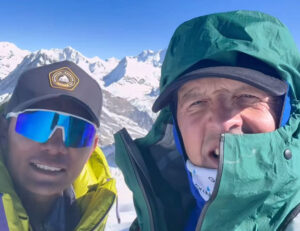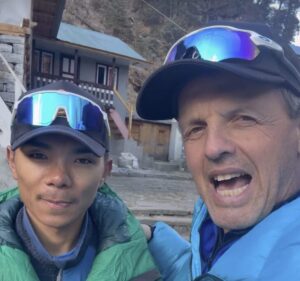Sergi Mingote is back in Nepal, with an ambitious set of goals. After leading a group of disabled trekkers up to Tengboche monastery and escorting them safely back to Kathmandu, he retraced his steps and marched on until Everest Base Camp, where he pitched his small tent. He doesn’t have much time for small-talking to BC neighbors: His plans include Lhotse, Everest and possibly Kangchenjunga before the monsoon hits that side of the Himalayas.
Then the Catalonian climber will switch to Pakistan, aiming to bag both Gasherbrums. Behind his hectic pace lies one of the most ambitious plans in high-altitude mountaineering, one which allegedly includes at least two Guinness World Records.

Sergi Mingote summited K2 without supplemental O2 in 2018.
Last year, Mingote knocked off Broad Peak, K2 and Manaslu. This year, he plans to complete the second half of his project by summiting the three highest mountains on Earth in less than a year.
This would smash the current Guinness Record held by 14×8000 summiter Silvio Mondinelli, who climbed K2, Everest and Kangchenjunga in three years and 74 days. “I am not certain I will manage, though,” Mingote admitted, “because climbing Lhotse and Everest without oxygen may leave me no time for Kangchenjunga before the end of the season.”
Mingote plans to hurry up Everest immediately after Lhotse, without descending back to Base Camp. He would then fly by helicopter to Kangchenjunga Base Camp. This seems to be the only option, since the mountain lies on the far western edge of Nepal, on the border with Sikkim.
Such an ambitious agenda has raised both questions and eyebrows in the climbing community. While we can’t do anything about the eyebrows, we put the questions to Mingote, who answered them directly:

Last year, Mingote bagged Broad Peak, K2 and Manaslu (pictured above). Now he’s back for more.
When, precisely, did you start the chronometer of your 3x2x8000 challenge?
The challenge to beat Mondinelli’s record to summit the three highest mountains on Earth in 365 days started on the summit of K2, on July 23, 2018. I also intend to summit as many 8000’ers as possible within 365 days. For that goal, the clock started when I summited Broad Peak one week before K2, on July 16.
And you climbed these without oxygen, right?
Yes, all the climbs in the project are without bottled oxygen. I summited K2 very fast because I had just climbed Broad Peak [and was well-acclimatized].
But you’re climbing too many mountains! If your goal is the three highest peaks, why Broad and Manaslu last year, and Lhotse now?
Well, I always apply for double climbing-permits and I am also aiming for a second Guinness record: Climbing six 8000’ers without O2 in less than 365 days.
Okay, so let’s go stage by stage: first you will attempt a no-O2 Lhotse-Everest double-header…
That’s right. I am heading for Lhotse first, hoping to reach the top on the first half of May, and then attempt Everest on the same push by retreating only to Camp 4 on the South Col, or maybe Camp 3, and then go back up for the top. Then I will see if I have time left for Kangchenjunga. It is complicated, but worth a try.
Phew…
Then I would go home to see the family for a few days. On June 13, I have to be in Islamabad to lead an international expedition to Gasherbrum I and Gasherbrum II. This would be the last chance to bag two more 8000’ers right before the deadline [that is, the day Mingote summited Broad Peak last year] on July 16.
And that is my project for the year. It will keep me up in the mountains until August.
Sorry if I am too blunt, but that sounds stressful. You’ll hardly have time to enjoy the view.

Mingote trains at a high-performance sport center near his home.
[Laughing] Well, in fact, the project was born in a collaboration with the High Performance Sport Centre in Sant Cugat [Barcelona] and aims to apply high athletic performance theory to high-altitude mountaineering. I come from the field of ultra-endurance sports: I’ve done Iron Mans and extra-long distance races. I took up 8000’er climbing 20 years ago. Now I feel it is the right moment to tackle such a challenge with the most possible options: On one hand, I am experienced enough in high-altitude mountaineering, and on the other I have been training full time at the HPSC with a whole team of experts supporting me.
But how about the acclimatization and the work on the route?
I’m just back from Ojos del Salado and two other volcanoes in Chile, which has helped me acclimatize, and I am ready to start setting camps as soon as I get to Lhotse. On Manaslu last year, it only took me 10 days to summit after reaching Base Camp. Speed is the key to keeping safe and climbing all these peaks in such a short time. I am eager, motivated and although the possibility of success is not so high, I’ll try anyway.
So your approach is basically sport-oriented?
Yes, that’s right. For me, the main motivation is to raise awareness towards inclusion through sports. I’ve collaborated with a number of disabled athletes. Then I’ve loved and pursued sports since I was three years old. Overall, I think there is currently too much discussion over what others do. People may question one particular method or another, such as climbing with no O2, but that is absurd. Everyone should climb mountains as they can and want.
Tell me about logistics. When you get to Lhotse Base Camp, do you expect to use higher camps already pitched and ropes already fixed along the route?
That depends on how I find the route. It has varied in my last three climbs: On Broad Peak, ropes were fixed up to C2, but we were the first to fix the upper sections and the first to top-out. Then, by the time I got to K2, I found the entire route fixed by the big commercial groups, and on Manaslu I got to Base Camp ahead of the rest of the teams and joined the Sherpas in charge of fixing the route. In fact, we climbed the last sections without fixed ropes. One needs flexibility. I have material and ropes to pass hard sections if needed. As for Lhotse, I’ll get there rather late in the season. I’ll pitch my camps as I see fit, autonomously.
Are you climbing with someone else, or hiring Sherpas?
I am sharing a permit with Juan Pablo Mohr from Chile, Juan Carlos Garranzo and another climber from Brazil. We are sharing logistics and the permit, but each of us has his own goals and priorities. I am not hiring high-altitude Sherpas. To some degree, all 8000’ers have fixed ropes, if only from previous seasons. So I’d rather focus on going light.

Mingote on the summit of Everest, which he climbed from the north side back in 2003.
So, you go for Lhotse first and then straight to Everest by traversing at some point?
I would like to descend as little as possible from the Lhotse summit — only back to C4 or C3 and definitely no further than C2 as I need to economize effort. I feel prepared and well-tested after climbing K2 without O2 and achieving the fastest Broad Peak/K2 double-header by breaking Boyan Petrov’s previous record. I have 20 years of experience and I have no pressure from anyone.
Speaking of pressure –- or the lack of it –- are you sponsored or self-financed? Yours is a long and surely pricey project.
I have stuck to the same model for the last 20 years: I have quite a few contributors helping me, but my source of income has been filming documentaries which I then screen at mountain festivals. I am a camera operator, I film a lot up there, I am part of a producing company and those documentaries pay for the climbing permit. Then, I keep a low budget by getting only the permit, no logistics.
So in addition to climbing, you are filming, all on your own?
Yes. That’s one of the toughest parts of my climbs, because I have to carry my two cameras and a drone in my backpack. Working professionally, a 30-40 minute documentary requires many hours of footage, and then the long work of script-writing, etc. Also, I give talks around Spain.
Do you feel you’re taking too many risks with such ambitious goals?
Well, I try to take as little risk as possible, but of course you take some risks in the end. On K2, I took a high risk because I was alone, everyone else had left but for Ali, who turned around 100 meters shy of the top as a storm approached. There, I admit, the stakes were really high. I was lost for four hours above 8000m until I finally found C4. It was quite epic. But it all depends on the mountain: Manaslu, on the other hand, was much faster and therefore safer.
Definitely you will not be alone on Everest. But I am not sure that’s going to be of any help on a no-O2 climb, perhaps the opposite. And after so many days at altitude, following another summit.
I agree, Everest is crowded, but no-O2 climbs are scarce. Everest without bottled O2 is a totally different mountain. It’s all about the style. There is risk, but the most important thing in my life is below 8000m — my family – and I am not willing to lose my life up there. I will try to keep objective risks under control. I aim for four or five 8000’ers, which is a lot, but I have also prepared thoroughly.

Mingote collaborates with several disabled athletes.
Editor’s note: Nirmal Purja is also currently pursuing an even more ambitious goal of summiting all 14 8000’ers in a single year.
Related stories:
Mingote Claims his Third 8,000’er
Mingote Targets His Second 8,000m Double-Header






